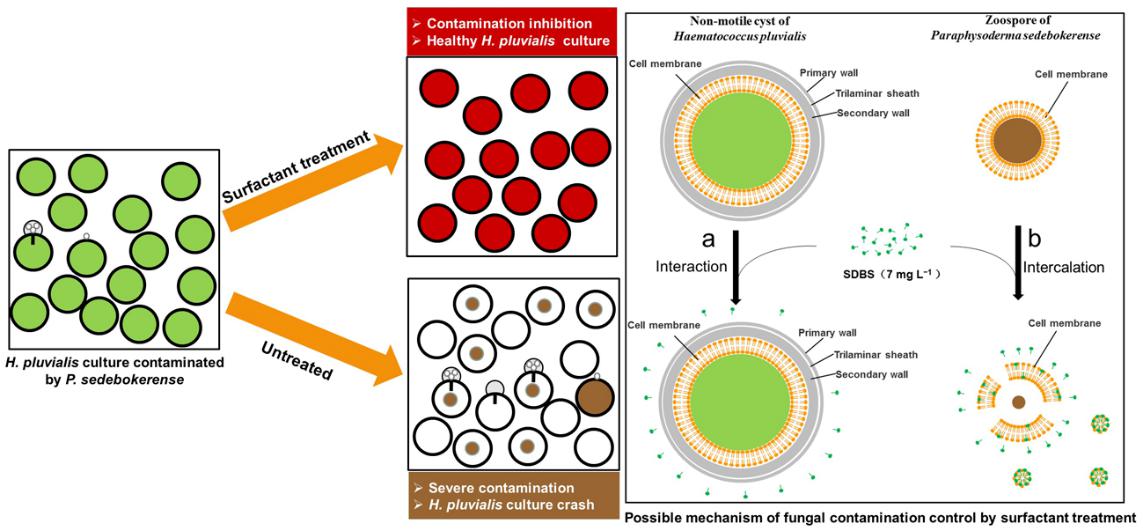Name:Yeguang Li
Tell:
Email:yeguang@wbgcas.cn
Organization:Wuhan Botanical Garden
Surfactants Application Controls Destructive Fungus Contamination in Mass Cultivation of Haematococcus pluvialis
2020-11-17
Astaxanthin is a superior natural antioxidant and has cardioprotective, neuroprotective, anti-cancerous, and anti-diabetic properties. These powerful properties have resulted in the extensive application of astaxanthin in food, aquaculture, cosmetics, nutraceuticals and pharmaceuticals.
Haematococcus pluvialis is considered as the best and richest source for natural astaxanthin production. H. pluvialis cells can accumulate astaxanthin up to 5% of dry biomass under stress conditions. However, large-scale cultivation of H. pluvialis is frequently contaminated by the destructive fungus Paraphysoderma sedebokerense, which can cause huge losses in astaxanthin production.
Researchers from the Microalgae Biotechnology Research Group of Wuhan Botanical Garden recently established a new approach to control destructive fungus contamination in mass cultivation of H. pluvialis.
In laboratory experiments, the results showed that 7–10 mg L-1 sodium dodecylbenzene sulfonate (SDBS), 60 mg L-1 sodium dodecyl sulfate (SDS) and 30–40 mg L-1 primary alcohol ethoxylate (AEO-7) effectively controlled P. sedebokerense contamination and sustained the control effect for 12 days.
Moreover, SDBS was the most promising because treatment at 7 mg L-1 was effective against fungal infection without negatively affecting the growth and astaxanthin contents of H. pluvialis. This could be ascribed to the different cell coverings and structures of H. pluvialis and P. sedebokerense. The green or red cysts of H. pluvialis have a voluminous multilayered cell wall, which could hamper SDBS penetration into the algal cell membrane, or even form a protection against SDBS. In contrast, the zoospores of P. sedebokerense lack protective cell walls.
This allows SDBS to directly penetrate the cell membrane of P. sedebokerense, which could result in disruption of the cell membrane, leakage of intracellular components, and cell lysis. Thus, this difference in SDBS resistance between H. pluvialis and P. sedebokerense is necessary for successful application of SDBS to control fungal contamination during mass cultivation of H. pluvialis.
Furthermore, SDBS was applied in open raceway pond culture of H. pluvialis to control fungal contamination, and the astaxanthin production reached 1.82 g m -2.
With a market price of 1.4 $ kg-1 SDBS, the cost for controlling P. sedebokerense infection in 1000 L ponds was only 0.01$. Additionally, in comparison with previously reported methods such as temperature control and acidic cultivation strategy, SDBS treatment can control P. sedebokerense infection much more quickly and easily. Therefore, this economical and effective control strategy has great potential in the commercial production of astaxanthin from H. pluvialis.
This work was supported by the National Natural Science Foundation of China. Results have been published in Bioresource Technology entitled “Application of surfactants for controlling destructive fungus contamination in mass cultivation ofHaematococcus pluvialis”

Application of surfactants for controlling destructive fungus contamination in mass cultivation of Haematococcus pluvialis (Image by WBG)